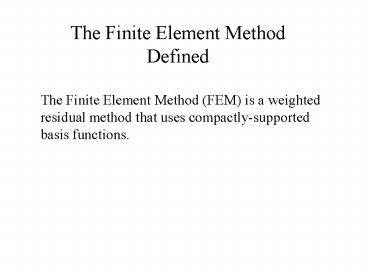An Introduction to the Finite Element Method - PowerPoint PPT Presentation
1 / 27
Title:
An Introduction to the Finite Element Method
Description:
The Finite Element Method (FEM) is a weighted residual method that uses ... We still haven't done the 'finite element method' yet, we have just restated the ... – PowerPoint PPT presentation
Number of Views:62
Avg rating:3.0/5.0
Title: An Introduction to the Finite Element Method
1
The Finite Element Method Defined
The Finite Element Method (FEM) is a weighted
residual method that uses compactly-supported
basis functions.
2
Brief Comparison with Other Methods
Finite Difference (FD) Method FD approximates an
operator (e.g., the derivative) and solves a
problem on a set of points (the grid)
Finite Element (FE) Method FE uses exact
operators but approximates the solution basis
functions. Also, FE solves a problem on the
interiors of grid cells (and optionally on the
gridpoints as well).
3
Brief Comparison with Other Methods
Spectral Methods Spectral methods use global
basis functions to approximate a solution across
the entire domain.
Finite Element (FE) Method FE methods use
compact basis functions to approximate a solution
on individual elements.
4
Overview of the Finite Element Method
Strong form
Weak form
Galerkin approx.
Matrix form
5
Sample Problem
Axial deformation of a bar subjected to a uniform
load (1-D Poisson equation)
L
u axial displacement EYoungs modulus
1 ACross-sectional area 1
6
Strong Form
The set of governing PDEs, with boundary
conditions, is called the strong form of the
problem. Hence, our strong form is (Poisson
equation in 1-D)
7
Weak Form
We now reformulate the problem into the weak
form. The weak form is a variational statement
of the problem in which we integrate against a
test function. The choice of test function is up
to us. This has the effect of relaxing the
problem instead of finding an exact solution
everywhere, we are finding a solution that
satisfies the strong form on average over the
domain.
8
Weak Form
Strong Form
Residual R0
Weak Form
v is our test function We will choose the test
function later.
9
Weak Form
Why is it weak? It is a weaker statement of
the problem. A solution of the strong form will
also satisfy the weak form, but not vice
versa. Analogous to weak and strong
convergence
10
Weak Form
Choosing the test function We can choose any v
we want, so let's choose v such that it satisfies
homogeneous boundary conditions wherever the
actual solution satisfies Dirichlet boundary
conditions. Well see why this helps us, and
later will do it with more mathematical
rigor. So in our example, u(0)0 so let v(0)0.
11
Weak Form
Returning to the weak form
Integrate LHS by parts
Integrate
12
Weak Form
Recall the boundary conditions on u and v
Hence,
H
The weak form satisfies Neumann conditions
automatically!
13
Weak Form
Why is it variational?
u and v are functions from an infinite-dimensional
function space H
14
Galerkins Method
We still havent done the finite element method
yet, we have just restated the problem in the
weak formulation. So what makes it finite
elements? Solving the problem locally on
elements Finite-dimensional approximation to an
infinite- dimensional space ? Galerkins Method
15
Galerkins Method
16
Galerkins Method
17
Galerkins Method
18
Galerkins Method
- So what have we done so far?
- 1) Reformulated the problem in the weak form.
- 2) Chosen a finite-dimensional approximation to
the solution. - Recall weak form written in terms of residual
This is an L2 inner-product. Therefore, the
residual is orthogonal to our space of basis
functions. Orthogonality Condition
19
Orthogonality Condition
The residual is orthogonal to our space of basis
functions
u
H
Hh
uh
fi
Therefore, given some space of approximate
functions Hh, we are finding uh that is closest
(as measured by the L2 inner product) to the
actual solution u.
20
Discretization and Basis Functions
Lets continue with our sample problem. Now we
discretize our domain. For this example, we will
discretize x0, L into 2 elements.
0
h
2hL
In 1-D, elements are segments. In 2-D, they are
triangles, tetrads, etc. In 3-D, they are
solids, such as tetrahedra. We will solve the
Galerkin problem on each element.
21
Discretization and Basis Functions
For a set of basis functions, we can choose
anything. For simplicity here, we choose
piecewise linear hat functions. Our solution
will be a linear combination of these functions.
f3
f1
f2
x10
x2L/2
x3L
22
Discretization and Basis Functions
To save time, we can throw out f1 a priori
because, since in this example u(0)0, we know
that the coefficent c1 must be 0.
f3
f2
x10
x2L/2
x3L
23
Basis Functions
f3
f2
x10
x2L/2
x3L
24
Matrix Formulation
25
Solution
26
Solution
Notice the numerical solution is interpolatory,
or nodally exact.
27
Concluding Remarks
- Because basis functions are compact, matrix K is
typically tridiagonal or otherwise sparse, which
allows for fast solvers that take advantage of
the structure (regular Gaussian elimination is
O(N3), where N is number of elements!). Memory
requirements are also reduced. - Continuity between elements not required.
Discontinuous Galerkin Method































